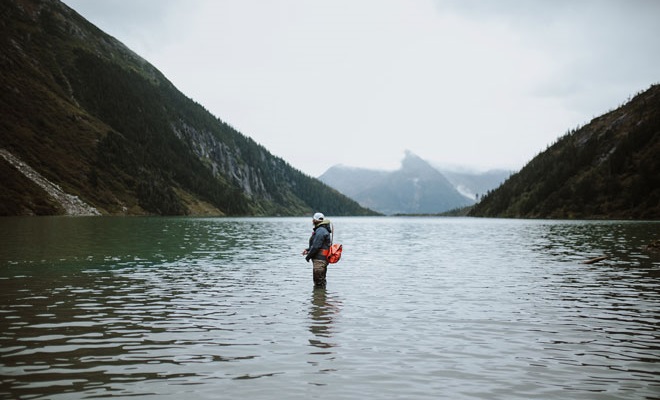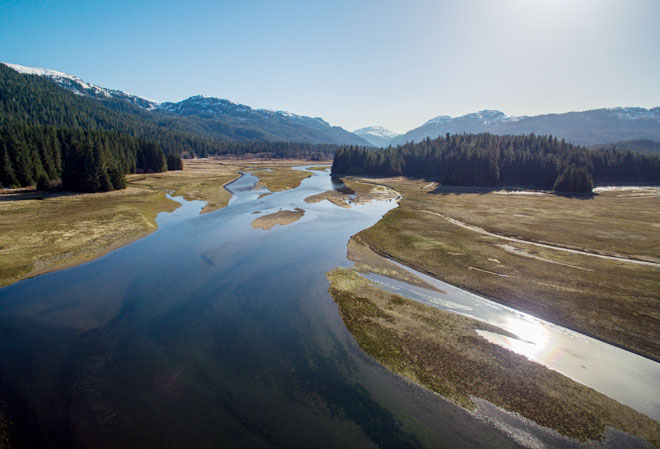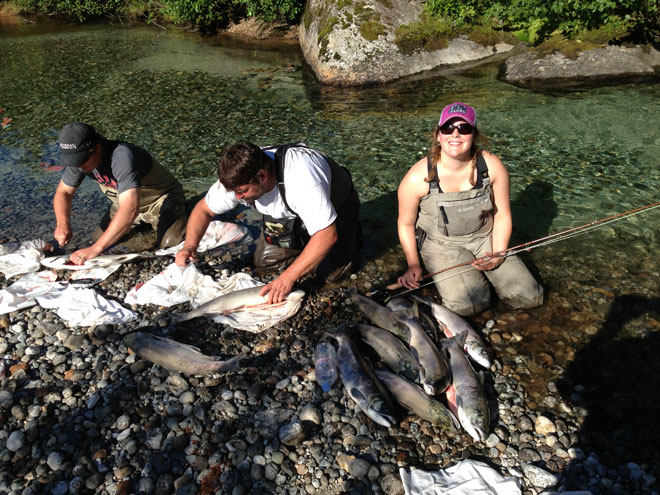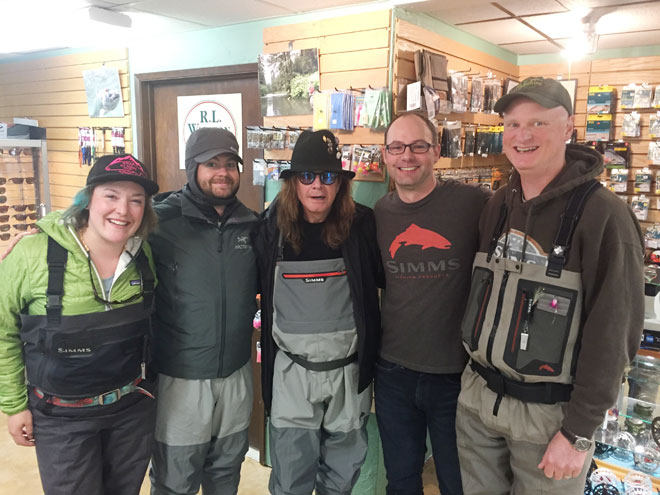Tongass National Forest
Blog by Kayla Roys, Trout Unlimited

Fishing an alpine lake in southeast Alaska. © Sydney Akagi Photography
Those who know southeast Alaska likely and rightly imagine mountains erupting out of the saltwater coast and streams, lakes, rivers, and saltwater flats that weave through muskeg meadows, old-growth forests, and glacial valleys. These features of the Tongass National Forest—our nation’s largest—create the lush landscape and alluring scenery that invite enthusiastic admirers each year.
The Tongass offers incredible outdoor recreation opportunities including fishing for all five species of Pacific salmon, hunting, hiking, whale watching, kayaking and much more.
Growing up in the Tongass, I’ve learned that people in the community relate to one another around a shared interest in the outdoors—what we’re hunting, catching, foraging and summiting. For me, that passion has always been fishing. My grandfather was a fisheries biologist with a certain interest in cutthroat trout, and my mother and father were both avid anglers—throwing rod and reel and trolling the shores. I grew up in and out of floatplanes and boats, traveling to and from remote lakes and around distant coastlines.

Saltwater flats weaving through the Tongass. © Joshua Duplechian
Witnessing the impact of salmon on the coastal towns in southeast Alaska, I was raised with an imbedded knowledge that our wild salmon are more than just a passion for the people who live here. They are also a way of life and the backbone of southeast Alaska’s economy.
The fishing and tourism industries in southeast Alaska account for 26% of the jobs, as well as adding $2 billion annually to the local economy. The forested areas surrounding the small communities of Southeast are mostly comprised of old-growth western hemlock, Sitka spruce, and yellow and red cedar trees. The old-growth aspect is key, because from the soil to the canopy of the forests, it creates a diverse habitat that provides wildlife—such as Pacific salmon, bald eagles, brown and black bears, Sitka blacktail deer, wolves and more—the shelter and forage they need to thrive.

Fly-caught sockeye for the winter freezer. © Michael Stevenson
Growing up in such a wild place and finding my own voice in a community of anglers, I wanted to do all I could to protect these wild places that I love so much. I reached out to my peers, joined volunteer organizations, and eventually found a home with Trout Unlimited. I have learned many things about the public processes that go into protecting these areas, the Tongass 77 areas of the forest, the Roadless Rule in Alaska, local restoration projects, and how the general public can weigh in on issues that impact the places they love to hunt, fish, gather, and play.
Atop the list of our work is conserving areas like the Tongass 77 that are especially important to fish and wildlife and the people that use them. Roughly a decade ago, Trout Unlimited joined forces with scientists, federal and state biologists, outfitters and guides, commercial fishermen, and stakeholders from a variety of walks of life to identify the most prolific trout- and salmon-producing areas in the Tongass and set out to create additional conservation measures to ensure their long-term productivity. Maintaining natural salmon production as well as the health and function of fish and wildlife habitat in these areas is a top priority.
Through the years immersed in the flyfishing community, I have hosted film festivals and taught more than 100 men and women how to flyfish. One of them was Ozzy Osbourne on a trip to Alaska in 2017. I cannot say he was the best caster, but he was great at catching the bottom-dwelling sculpin! I have planted trees on riverbanks, attended meetings about salmon and trout populations, tied flies in bars, and made countless friends. Having a hand in building this community, growing the knowledge and support around conservation efforts in the region has been a highlight of mine.

The Prince of Darkness (Ozzy Osbourne) along with his son Jack, and the team at Alaska Fly Fishing Goods in Juneau. © Alaska Fly Fishing Goods
Most recently, my colleagues at Trout Unlimited and I delved into the roadless rulemaking process in Alaska. The Roadless Rule, which was created nearly 20 years ago, generally prohibits new logging roads and commercial logging in areas where logging and roads don’t already exist. The rule is set up to be flexible for the communities of Southeast and doesn’t restrict outdoor recreation, forest restoration, energy projects, oil, gas, and mineral exploration and development, or community infrastructure, among various other uses of the forest. However, in 2018 the state of Alaska petitioned the Secretary of Agriculture and U.S. Forest Service to exempt the Tongass from the Roadless Rule, a move that would quite literally turn more than nine million acres of our forest into stumps.
Attending meetings over the last year, each made one idea very clear: Alaskans want the Roadless Rule to stay in place. During the most recent public comment period, 96% of those who commented communicated support for protecting roadless areas and important fish, wildlife, and recreation habitat in the Tongass. In meetings, Alaskans stated the obvious, time and time again: We value our fish and wildlife, and travelers do not come to the Tongass to see clear-cut swaths of land; they come to see the unique wilderness that still thrives here. Scientists and other experts stated that industrial-scale logging and logging roads negatively impact fish and wildlife by creating erosion that degrades water quality and smothers salmon-spawning areas, often blocks salmon migration and reduces valuable shelter that deer need to survive the winter. Despite this, the Forest Service could still remove the Roadless Rule on the Tongass later this year.
To me, the Tongass will always be home. I’ll continue to relate to my neighbors best during salmon season as we fillet beautiful, chrome fish under the midnight sun. But I know, more broadly, there are few places in the world where you can step out your front door and be fishing, hunting, hiking, or exploring within minutes. That is why the Tongass is such a treasure. If you plan to visit in the future, or would just like to learn more, check out AmericanSalmonForest.org to see how you can help ensure it stays this way for years and generations to come.
This blog originally appeared as the Conservation column titled ‘Salmon: A Way of Life in Southeast Alaska’ in the October/November 2020 issue of Fish Alaska.
